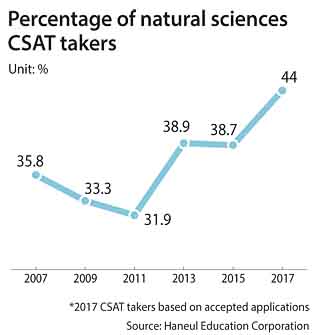Students choose science in large numbers, ignoring facts

A boys’ high school in Gangnam District, Seoul, conducted a survey that revealed only 13 out of 100 top-ranked students hope to study liberal arts. Out of the 20 best students, only two answered that they wish to study liberal arts. “I didn’t expect such a low turnout for liberal arts,” the principal said, “at least 30 percent of students chose liberal arts five years ago.”
A girls’ high school in the same district, whose students have favored liberal arts over the years, shows the same trend. A total of 70 students, out of 100 top-ranked students, answered that they want to study natural sciences. The principal said, “About 20 to 30 percent of students who choose natural sciences don’t manifest aptitude in the area, yet they refuse to consider liberal arts despite teachers’ advice.”
A higher preference for natural sciences results from easier college entrance and employment opportunities for natural sciences majors. “Many of my friends wish to enter college with a natural sciences major and double major in liberal arts,” said a student at a public high school in Gangnam.
“In regular admissions for universities based in Seoul,” Oh Jang-won, head of admissions at Dankook University High School, said, “the minimum required CSAT level for admission to a natural sciences program is 3.5 on average, but 2.5 for liberal arts.”
In either category, on a scale of 1 to 9, a CSAT level of 1 is perfect.
A total of 38 medical colleges, in addition, will raise their entrance quota from 2,299 in 2015 to 2,884 in 2019. Shin Dong-won, the principal at Whimoon High School in Seoul, said, “All high school students with good grades will now want to apply for medical colleges.”
But the unequal student distribution raises serious concerns, since high schools cannot keep up with the rising demand for natural sciences teachers. “It’s not easy to rely on a trend and hire more natural sciences teachers,” said a high school teacher in Gangnam, adding that “the class size for natural sciences curriculum is bigger than that of liberal arts by about three to four students and it’s difficult to manage such a class size.”
Blindly choosing natural sciences can also be problematic for students. Among current natural sciences students, 20.4 percent chose the curriculum despite poor aptitude test results, according to Haneul Education Corporation’s survey. Kim Hye-nam, a teacher at Moonil High School in Seoul, said, “Students need to be aware college admissions based on transcripts and school activities are increasing.”
Universities select an average of 20 percent of their students based on transcripts, while top universities in Seoul select above 40 percent on that basis. College admissions based on transcripts and school activities evaluate students’ extracurricular activities as well as their grades.
“As top-ranked students choose natural sciences, it’s somewhat easier for liberal arts students to succeed in a relative grading system,” Oh Jang-won said. “Students who choose natural sciences are likely to face difficulties participating in extracurricular activities.”
BY JUNG HYEON-JIN [kim.yuna1@joongang.co.kr]










with the Korea JoongAng Daily
To write comments, please log in to one of the accounts.
Standards Board Policy (0/250자)